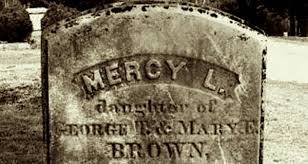When fear and superstition take hold of a small town, rational thinking often takes a back seat. This happened in Exeter, Rhode Island, at the end of the 19th century. Tuberculosis, a deadly disease with no cure at the time, was the leading cause of death. The town started to believe that a “vampire” named Mercy Brown was behind the tuberculosis-related deaths, despite her being dead. Let’s explore this eerie tale that remains a historical curiosity.
The Terror of Tuberculosis
In 1892, tuberculosis, also known as “consumption,” was a frightening disease in the United States. Its symptoms included fatigue, night sweats, and coughing up white phlegm or blood. Doctors often recommended rest, good nutrition, and outdoor exercise, but these were rarely effective. The survival rate for active tuberculosis was just 20%.
Tragedy Befalls the Brown Family
The Brown family in Exeter suffered several tragic losses. It began in 1884 when George Brown’s wife, Mary Eliza, died of tuberculosis. Two years later, their eldest daughter also succumbed to the disease. As more family members died, residents began to suspect a sinister force was at work.
The Mercy Brown “Vampire” Incident
In 1891, George Brown’s son, Edwin, fell seriously ill. He traveled to Colorado Springs for its better climate, but his condition worsened upon returning to Exeter in 1892. When 19-year-old Mercy Lena Brown died from tuberculosis, George became desperate. Townspeople, believing an old folk tale about the dead draining the life from the living, pressured George to act.
Dr. Harold Metcalf of Wickford directed the exhumation and examination of the bodies. In March 1892, they unearthed the bodies. While George Brown’s wife and eldest daughter were found as skeletons, Mercy’s body was remarkably well-preserved after nine weeks in the ground. Blood was found in her heart and liver, seemingly confirming the townspeople’s fears.
Mercy Brown’s Aftermath
Despite the doctor’s attempts to explain Mercy Brown’s preserved body scientifically, the superstitious locals insisted on removing her heart and liver and burning them. They mixed the ashes with water and gave it to Edwin, but this supernatural remedy failed; Edwin died two months later.
While vampire-inspired rituals involving exhumation and burning were not uncommon at the time, the Mercy Brown case marked the end of such practices in the region. The tale of the “Last New England Vampire” lives on. Mercy Brown’s relatives kept newspaper clippings and shared her story during Decoration Day when local cemeteries were decorated. Today, visitors leave unusual gifts, like jewelry and plastic vampire teeth, at her gravesite.
The vampire scare of the late 19th century reflected the lack of understanding about tuberculosis and the desperate search for a culprit. Advances in germ theory and hygiene eventually disproved these beliefs, but the Mercy Brown case remains a chilling reminder of a dark time in history.
To learn more about other infamous vampires, read about Peter Kürten, the Vampire of Düsseldorf, and the chilling story of the “Brooklyn Vampire” serial killer, Albert Fish.
